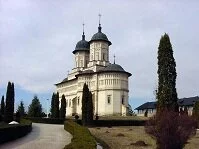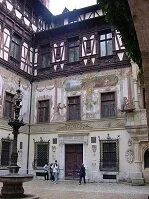
Cetatuia Monastery in Iasi
Over the next couple centuries, as the country was partially occupied and at odds with many of their neighboring powers, Romania developed a national pride, which was represented in many forms, including in their architecture. This style of art, called Brancoveanu Art, is best exemplified in the Monastery of Horezu (1690). This style, and in particular this building, is perhaps the purest Romanian building in the country.

Peles Castle in Sanaia
As was the traditional form of architecture in the 1700s and 1800s most construction was made from wood. Like various regions throughout the Carpathian Mountains, the region of Maramures in northern Romania built a number of wooden churches, which generally had steep slanting roofs to shed the snow. There are still a few of these wooden churches remaining in sporadic mountain villages.
Sadly, since the 1800s the most noticeable architectural style has been communist constructions that were built after World War II. These buildings encircle most large and medium sized cities in the country today, most notably Bucharest. Despite this, there are some more modern buildings of note. Peles Castle (1873-1914) in Sanaia is a neo-Renaissance palace with definite Saxon traits built by the king of Romania. Also during this time the Palace of the Parliament (or the Palace of the People) was built in Bucharest and remains the world's second largest building, built primarily in the communist style.